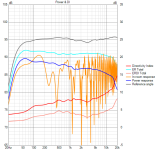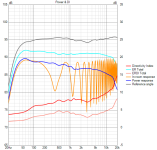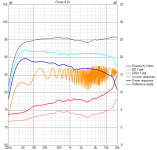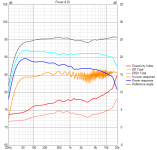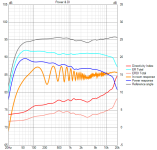I take it that you have read the Audioxpress article about the Live Edge dipoles. This was published a couple of years ago, and is now available online.
For the interest of followers of this thread, they can read it here:
https://audioxpress.com/article/you-can-diy-perry-marshall-the-live-edge-dipoles
I find it quite interesting- equal parts of engineering, equal parts of marketing, which perhaps reflects Perry’s professional background. It should pique interest in OB. Good job @perrymarshall
@CharlieLaub ’s Audioxpress article regarding his nude dipoles was published recently in the print and digital magazine. Do you have a subscription? If not, I wonder how our OP can read your article about your approach.
Charlie, are you under an exclusivity or non disclosure agreement with Audioxpress that prevents you from sharing your research with our OP?
For the interest of followers of this thread, they can read it here:
https://audioxpress.com/article/you-can-diy-perry-marshall-the-live-edge-dipoles
I find it quite interesting- equal parts of engineering, equal parts of marketing, which perhaps reflects Perry’s professional background. It should pique interest in OB. Good job @perrymarshall
@CharlieLaub ’s Audioxpress article regarding his nude dipoles was published recently in the print and digital magazine. Do you have a subscription? If not, I wonder how our OP can read your article about your approach.
Charlie, are you under an exclusivity or non disclosure agreement with Audioxpress that prevents you from sharing your research with our OP?
Last edited:
Here are supplementaries for Charlie's articles for download! https://audioxpress.com/page/audioXpress-Supplementary-Material
Live Edge dipoles have wide baffle with discontinuity around 1kHz, very sensitive area (almost 1 octave). Perry likes to add a backside horn... Sadly no 180deg measurements


Live Edge dipoles have wide baffle with discontinuity around 1kHz, very sensitive area (almost 1 octave). Perry likes to add a backside horn... Sadly no 180deg measurements
Last edited:
this thread on ASR shows results of several ABEC simualtions of dipoles, H and U frames in which the magnet structure seems to be modelled
U-frame simulations on ASR
U-frame simulations on ASR
re' Live Edge dipoles have wide baffle with discontinuity around 1kHz, very sensitive area (almost 1 octave).
Perry's article about the Live Edge dipoles got me thinking about OB. It seduced me away from thinking about cardioid. Then I recalled advice/rule not to use a driver past the dipole peak and realized that had to be violated in Perry's design. I looked at the FR graph you just posted and found that discontinuity at 1 khz. That is what is avoided in my design by using as small a baffle as possible around the coax driver.
Perry's article about the Live Edge dipoles got me thinking about OB. It seduced me away from thinking about cardioid. Then I recalled advice/rule not to use a driver past the dipole peak and realized that had to be violated in Perry's design. I looked at the FR graph you just posted and found that discontinuity at 1 khz. That is what is avoided in my design by using as small a baffle as possible around the coax driver.
Well, I am mostly wondering if people EVER read older topics, posts and other history?I can understand why there is little interest in OB simulations given how easy it is to experiment.
Because there is so much information on this. For me personally, it's mostly repeating the same stuff all over again that has been done 10 years ago.
There are a couple of refinements here and there, but that's about it.
No system is ever superior.As I recall, Linkwitz asserted that cardioid wasn't superior to OB but Kimmosto demonstrated impressively flat room response for a cardioid inside a small fully tiled bathroom.
It all depends context and variables.
From a practical point of view, a multi-sub system is much easier to implement, and the results are also way more predictable.
Plus the addition of being small as well as having more SPL.
So for most people, that's an awful lot more attractive, than having the need for some huge dipole frames.
The benefits for a dipole system quickly dissappear.
I don't disagree. If I need more SPL, I will add monopole subs. I've done the REW room sims to see I will likely need two of them. A dipole for 60 Hz up is a lot smaller than one for 30 Hz up. Where I see dipole as a win is in reducing boundary interference. A toed in dipole reduces all the boundary nulls except for the floor null. I've been trying to reduce the floor null by driver placement and choice of XOs but lost the formula in this version.
Attachments
Or with less SPL or the same SPL, you can just go for smaller 🙂 😉I don't disagree. If I need more SPL, I will add monopole subs.
Btw, I wasn't saying that dipoles are bad, but just that monopole subs are more practical in my experience.
@nc535 @CharlieLaub Charlie brought my attention to this, somehow I had missed it. Thread has been running awhile, so @nc535 I hope you didn't think I was aloof or ignoring you. This is a fantastic thread and I love where you're going with it. I hope to add more to this discussion on a different day. I salute you for your fine-grained rigorous approach to this.
From a practical point of view, a multi-sub system is much easier to implement, and the results are also way more predictable.
Plus the addition of being small as well as having more SPL….
The benefits for a dipole system quickly dissappear.
IMO the potential (!) benefits of OB or cardioid are in the couple octaves above the subwoofers. You can’t address room issues in that region with subs. MIMO room correction such as Dirac ART and monopoles might do it.
One of my design objectives has been to minize the response dip to the floor reflection, which usually occurs around 350 Hz. By crossing between midwoofer and woofer at nominally 300 Hz, I get some overlap that has the desired effect. Operating the Uframe that high introduces concerns about pipe resonances in the Uframe. These are reduced by limiting its depth, which in turn limits the low end extension. To get the best of both worlds, one needs to introduce damping into the Uframe, which turns it into a cardioid. Experimenting with that, I found I didn't like the transition from cardioid woofer to dipole midwoofer. It had a wid axial peak there because one can hardly expect cardioid directivity to match that of a dipole, except perhaps with a very lightly damped Uframe cardioid that is transitioning to dipole at the high end of its range. that was the objective in the simulation whose results are attached below, but it wasn't achieved
The Gradient Helsinki achieves very nice polars using a dipole woofer, cardioid midrange and waveguide tweeter

The placement of the woofer is quite odd; the dipole null points towards the listener (mostly)
I've tried this myself, in my relatively small office, and found that I preferred how a dipole sub sounded with the null pointed towards me. I think this works for a few reasons:
1) with the null pointed towards me, the source of the bass doesn't appear to be the woofer. To a great extent, you're hearing the reflection off the sidewalls. Sidewall reflections are no good for a midrange or a tweeter, but with bass, the wavelengths are so long, it doesn't sound like you're hearing two sources. 150Hz is 2.3 meters long; that's so long, the original source and the reflection seem to blend together.
2) Corners of a room are bad news for bass. With the woofer rotated 90 degrees, the null is pointed at the corner of the room, largely eliminating the need for any kind of treatment
3) You can put the speaker cabinet closer to the wall in a setup like, compared to what's possible with a conventional forward facing dipole
A few of our cardioid and dipole experts weigh in here, in this ten year old thread:
https://www.diyaudio.com/community/threads/who-likes-gradient.231107/page-2
It might be overkill, but here's a couple of woofer options that people might be interested in for dipole or cardioid use:
https://stereointegrity.com/product/ht-18-v3/
Stereo Integrity brought their HT-18 sub back about a year or two ago. I have one of the original ones. It weighs less than a lot of my twelves or even eights, because it has a high VAS and high QTS. Yes the motor is kinda small, but it's hard to argue with 25mm of xmax.
Also, there's a pair of Adire Audio Maelstroms on eBay right now. They haven't been for sale for twenty years, but IIRC, they were basically a high excursion / low FS version of the Eminence Kilomax 18 mentioned earlier in this thread. They're only $100.
https://stereointegrity.com/product/ht-18-v3/
Stereo Integrity brought their HT-18 sub back about a year or two ago. I have one of the original ones. It weighs less than a lot of my twelves or even eights, because it has a high VAS and high QTS. Yes the motor is kinda small, but it's hard to argue with 25mm of xmax.
Also, there's a pair of Adire Audio Maelstroms on eBay right now. They haven't been for sale for twenty years, but IIRC, they were basically a high excursion / low FS version of the Eminence Kilomax 18 mentioned earlier in this thread. They're only $100.
There are no room modes a couples of octaves above subwoofer region?IMO the potential (!) benefits of OB or cardioid are in the couple octaves above the subwoofers. You can’t address room issues in that region with subs. MIMO room correction such as Dirac ART and monopoles might do it.
Active room correction is also not the right way at those higher frequencies.
Move your head a couple of inches and it's all gone. It's mostly asking for more trouble than having good benefits.
I am also not a fan of Dirac systems at all.
Magic one button solutions very rarely help well in acoustics.
Personally I find cardioids a lot more effective.
I have heard a very familiar setup and I think it's terrible.The placement of the woofer is quite odd; the dipole null points towards the listener (mostly)
Again more from a practical point of view.
Most of all, you're loosing even more output power.
But also pushing out more power on the side is what most other room/house mates/family won't appreciate.
It's really noticeable.
It feels so much of fixing a non existing problem.
Sound wise it also sounds a bit odd, especially when you're to close to that null.
There was another driver configuration I studied that is worth showing. I started with the premise that triple15's were too big and also too heavy and also that I needed to taper the baffle down to a smaller coax to get smoother response through the XO to the coax CD/tweeter. The next step down started with the BMS12C362. My attention was drawn to this driver by @airvoid. Its CD response is smoother through the top octave than most others.
The first attachment is Sketchup image with a 1.6m tall person for scale.

Next the Vituix screenshot. The linearity isn't quite as good as the version with the 8" tweeter. However, I was quite enthused with this response and only scaled down to the 8" when I saw that this one looked cramped in its intended space. The difference in linearity is solely due to the size of the coax - smaller coax permits narrower baffle which in turn allows smooth dipole response to extend higher.


The first attachment is Sketchup image with a 1.6m tall person for scale.
Next the Vituix screenshot. The linearity isn't quite as good as the version with the 8" tweeter. However, I was quite enthused with this response and only scaled down to the 8" when I saw that this one looked cramped in its intended space. The difference in linearity is solely due to the size of the coax - smaller coax permits narrower baffle which in turn allows smooth dipole response to extend higher.
You must have some husky 8's. This thing weights 33 lbs. Were it not for that I would be tempted to use it.It might be overkill, but here's a couple of woofer options that people might be interested in for dipole or cardioid use:
https://stereointegrity.com/product/ht-18-v3/
Stereo Integrity brought their HT-18 sub back about a year or two ago. I have one of the original ones. It weighs less than a lot of my twelves or even eights, because it has a high VAS and high QTS. Yes the motor is kinda small, but it's hard to argue with 25mm of xmax.
Also, there's a pair of Adire Audio Maelstroms on eBay right now. They haven't been for sale for twenty years, but IIRC, they were basically a high excursion / low FS version of the Eminence Kilomax 18 mentioned earlier in this thread. They're only $100.
I've so far been unable to find Charlie's article. I subscribe to VoiceCoil and searched through the Project Articles on the Audioxpress website but so far no joy. I would really love to read it.@CharlieLaub ’s Audioxpress article regarding his nude dipoles was published recently in the print and digital magazine. Do you have a subscription? If not, I wonder how our OP can read your article about your approach.
Charlie, are you under an exclusivity or non disclosure agreement with Audioxpress that prevents you from sharing your research with our OP?
AudioXpress severely edited (or butchered would be a more appropriate term) my article.@CharlieLaub ’s Audioxpress article regarding his nude dipoles was published recently in the print and digital magazine. Do you have a subscription? If not, I wonder how our OP can read your article about your approach.
Charlie, are you under an exclusivity or non disclosure agreement with Audioxpress that prevents you from sharing your research with our OP?
If anyone reading this wants a copy of the original version just PM me and I will send you a pdf or link.
Ha! It does seem like it's become a collection of press releases lately. All I really read it for is the patent and driver reviews now.
- Home
- Loudspeakers
- Multi-Way
- Dipole and Uframe models and discussion re' Live Edge Dipoles
